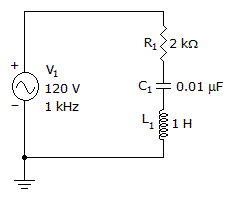Discussion
Home ‣ Electronics ‣ Ohm's Law See What Others Are Saying!
- Question
The number of joules used in 1 second is always equal to the number of _______.
Options- A. siemens
- B. coulombs
- C. amperes
- D. watts
- Correct Answer
- watts
- 1. If a 1 kΩ and a 2 kΩ resistor are parallel-connected across a 12 V supply, how much current is received by the 2 kΩ resistor?
Options- A. 4 mA
- B. 6 mA
- C. 8 mA
- D. 12 mA Discuss
- 2. A portion of the output that provides circuit stabilization is considered to be:
Options- A. negative feedback
- B. distortion
- C. open-loop
- D. positive feedback Discuss
- 3. The voltage across the inductor is 77.8 volts.

Options- A. True
- B. False Discuss
- 4. Regardless of whether the transformer is step-up or step-down, power in the primary equals the power in the secondary if there is 100% efficiency.
Options- A. True
- B. False Discuss
- 5. A rectifying diode can change ac voltage to dc voltage.
Options- A. True
- B. False Discuss
- 6. The gain of a BJT is called _______ and the gain of a JFET is called _______.
Options- A. beta, alpha
- B. transconductance, beta
- C. beta, transconductance
- D. transconductance, transconductance Discuss
- 7. The Q of a crystal _________.
Options- A. is extremely low
- B. is about 40 or so in most cases
- C. is extremely high
- D. none of the above Discuss
- 8. 106,100,000 Hz is the same as ___ MHz.
Options- A. 106.1
- B. 1,061
- C. 10,610
- D. 106,100 Discuss
- 9. You could increase the time constant of an RC circuit by
Options- A. adding a resistor in parallel with the circuit resistance
- B. adding a capacitor in parallel with the circuit capacitance
- C. increasing the amplitude of the input voltage
- D. exchanging the position of the resistor and capacitor in the circuit Discuss
- 10. The register in the 8085 microprocessor that is used to keep track of the memory address of the next opcode to be run in the program is the ________.
Options- A. stack pointer
- B. program counter
- C. instruction pointer
- D. accumulator Discuss
More questions
Correct Answer: 6 mA
Correct Answer: negative feedback
Correct Answer: False
Correct Answer: True
Correct Answer: True
Correct Answer: beta, transconductance
Correct Answer: is extremely high
Correct Answer: 106.1
Correct Answer: adding a capacitor in parallel with the circuit capacitance
Correct Answer: program counter
Comments
There are no comments.More in Electronics:
Programming
Copyright ©CuriousTab. All rights reserved.
